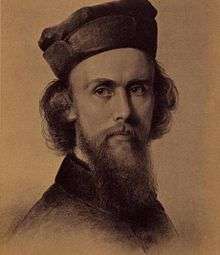Benjamin Paul Akers
| Benjamin Paul Akers | |
|---|---|
|
Photo portrait of Paul Akers | |
| Born |
July 10, 1825 Westbrook, Maine |
| Died | May 21, 1861 (aged 35) |
| Nationality | American |
| Known for | Sculpture |
| Awards | Commemorative Silver Medal in 1854 |
| Patron(s) | Samuel Appleton and John Neal |
Benjamin Paul Akers (July 10, 1825 – May 21, 1861) was an American sculptor, from Maine.
Early life
Born in Saccarappa, Maine in 1825, into a large and indigent family of rural Maine. When his father, Deacon Akers, moved the family from Saccarappa to Salmon Falls on the Saco River, he started a wood-turning mill. For six years as a young man he worked in his father's "wood turning" mill. There he invented beautiful patterns and "turned" toys. His brother, Charles "Carl" Akers was also a sculptor and crayon portrait artist. He wrote articles on art for the Atlantic Monthly and also "The Crayon" a short-lived, New York art magazine in the mid-19th century.[1] He spent the winter of 1849 in Boston learning the art of plaster casting with the sculptor, Joseph Carew. In 1850 he opened a studio in Portland, Maine. He received a "Commemorative Silver Medal" in the 1854 Exhibition and Fair of the Maine Charitable Mechanic Association. He moved to Boston in 1849 where he was an apprentice. The award was for his bas relief called "Peace".[2] In 1855, at age 30, he went to Rome, Italy where he worked for several years.[3]
Career
Among his works are busts of Edward Everett and Henry Wadsworth Longfellow, a head of John Milton and [[The Dead <ref>Portland Museum of Art</ref> Pearl Diver]], on display at the Portland Museum of Art in Portland, Maine. Nathaniel Hawthorne described Dead Pearl Diver as an important work of the protagonist, Kenyon, in his novel The Marble Faun, acknowledging his debt to Akers in the introduction.
Marriage and children
In 1858 he met Elizabeth Akers Allen a young mother, journalist and poet. They married in August 1860. Their only child, Gertrude Rothermel, died in infancy. He died in Philadelphia, Pennsylvania on May 21, 1861 from tuberculosis.[4] He is buried in Evergreen Cemetery (Portland, Maine).[5]
Gallery
 The Dead Pearl Diver by Benjamin Paul Akers. Portland Museum of Art
The Dead Pearl Diver by Benjamin Paul Akers. Portland Museum of Art- Samuel Appleton by Benjamin Paul Akers - Longfellow National Historic Site - DSC04802
Museums and public art galleries worldwide
- Boston Museum of Fine Art, Boston, Massachusetts
- Harvard University Art Museums, Massachusetts
- Portland Museum of Art, Maine [6]
Books About Benjamin Paul Akers
- Akers, Benjamin Paul by Thomas William Herringshaw
- Akers, Benjamin Paul, article in National Cyclopedia of American Biography, Vol. 6
- Akers, Benjamin Paul, book by George C. Groce
- The Brick House and Its People, book ca. 1930 by Janet Webb Hobbs
- Akers Brothers: brief sketch concerning those American artists, book ca. 1900 by Franklin Staples
National art databases and museum inventories
- Smithsonian American Art Museum National art inventories
References
- ↑ Archives of American Art
- ↑ Usher, Leila Woodman (1895). "Benjamin Paul Akers". New England magazine: an illustrated monthly. 11: 461–468.
- ↑ Maine Memory
- ↑ Chest of Books
- ↑ Find-A-Grave
- ↑ Art Encyclopedia
External links
- Benjamin Paul Akers letter collection, 1858-1920 from the Smithsonian Archives of American Art
